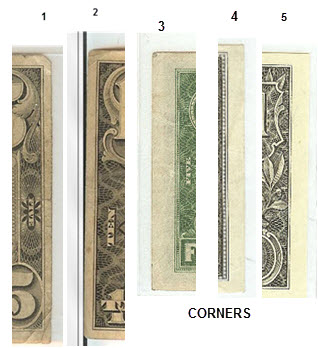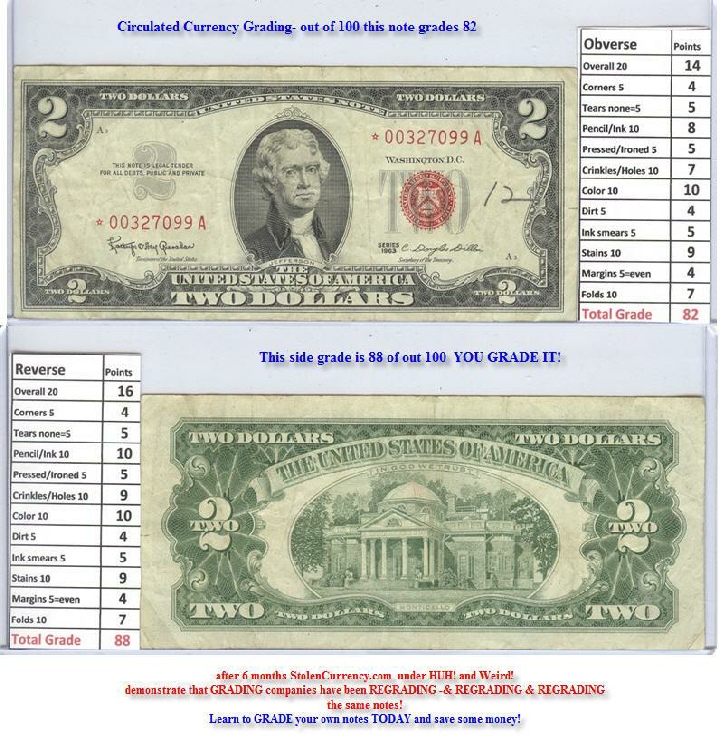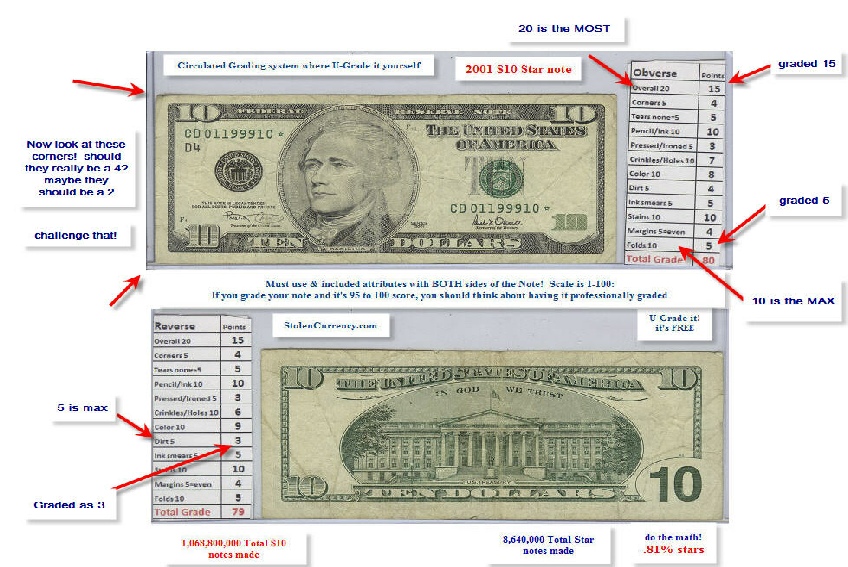This Website is so you can “Rate-
The Obverse side
(This is the side where the serial number is)
1. Open the Spreadsheet where your template is…
Free Template HERE: http://stolencurrency.com/grading1/grading1.html
2. The first item is “OVERALL” condition. We will enter this item LAST after we inspect this note. We just want you to be aware of this while looking at the NOTE.
3. Corners on a scale from 0 to 5 make a judgement on the condition of the Corners look like. 5 is Perfect: 4 is slightly round: 3 is more round: 2 is very round: and 1 is extremely round: 0 you cannot see a corner.
4. TEARS on a scale form 0 to 5 make a Judgement on the condition if there are ANY tears on the note. 5= no tears: 4=very slight edge tear: 3=tear on the margin only: 2=torn ¼ way through: 1 torn ½ way through: 0= IF there is TAPE on it. & torn most of the way through the note but not separated. (Never repair the note. But if you want to Google it..go for it)
5. Pencil or Ink marks on a scale from 0 to 10 determine how many pencil or ink marks are on the note. It’s your grade, so grade fair. 0 if marks were ERASED Leave the marks! Never erase!
7. Crinkles/Holes on a scale from 0 to 10 look at the note up to the light and search for holes. Crinkles are harder to determine but you will learn over time. Holes are kind of bad, but not unreasonable. Some people love their staple guns…. If it’s an OLD note, try to be fair.
8. Color: on a scale from 0 to 10 look at the entire Obverse side and determine the Color is even across the entire surface. Wear removes Color! 0 if they were erased
9. DIRT: you need to determine the amount of Dirt on this note on a scale from 0 to 5. 5 being no dirt found: 4 a small amount: 3=a little: 2= lots more: 1=a lot: & 0=tons of dirt
10. Ink Smears: 0 to 5 scale 5=being NONE: 4=a little: 3=more: 2=lots more: 1=much more: 0= tons
11. Stains: scale from 0 to 10, 10=NO STAINS 9. Coffee, blood, water on the margin. 8. Slightly in the note. 7 1/4” into the note. 6 more 5 ½ into the note 4. Heavy -
12. Margins even: scale 0 to 5 5=very EVEN 4. One side Slightly 3. 2 sides off. 2. All three are there. 1 slightly there…. You need to see a Margin. IT COULD BE AN ERROR!
13. FOLDS: scale is 0 to 10 10 no folds: 9=very small fold: 8=small fold: 7=folded in half: 6=folded two places: 5=folded Horizontal & Vertical: 4=massive fold: 3 lots of folds: 2 folded all over

Print out the spreadsheet “selected” Obverse & Reverse items. Cut each out & put back to back in the Large Currency Holder. (You should not print the entire sheet)
Large Currency Holder… USE the blank side of the Note for ID… and important data, ie: date bought, how much paid, who bought from. Use a Pencil so u won’t see your data and it’s erasable
LAST: LOOK at the OBVERSE of your note & determine:
The OVERALL Condition on a scale from 0 to 20. 20 being absolutely perfect: 19=perfect: 18=near perfect: 17=perfect: 16= almost perfect: 15=just about great, 14=, 13=, 12=, 11=, 10=, it’s your call
BOTH sides of a Circulated note are always graded. Flip the note over and start with number 2.
It will sharpen your Grading skills as you grade more notes.



2. If you need a spreadsheet software: http://www.openoffice.org/
If it's NOT a Star note you need to go here to get data:
http://www.uspapermoney.info/serials/
6. Pressed or Ironed on a scale from 0 to 5 determine if the note has ever been pressed or ironed. This is not as easy as it looks, but TRY. The embossing will be flat on a NEW note. It may not show up on an older note.
Updated 6/2/2015 by AJ Williams all Rights Reserved
QUESTIONS: aj@circulatedCurrency.com
This RATING system is FREE to anybody who wants to use it. It does NOT give you a Value of your Note, just a number from 0 to 100. It’s used by you for your Collection COLLECTION.